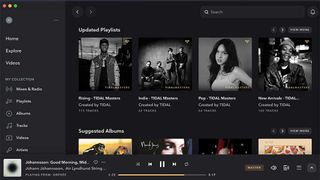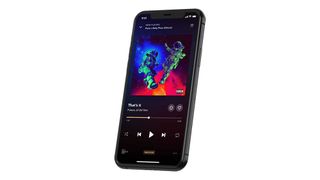Tidal: cost, streaming tiers, artists, features and everything else you need to know
The music streaming service for fans of high-quality audio

There are plenty of music streaming services to choose from right now, but for the fans of hi-fidelity audio and those looking to reap the benefits of a good speaker system, Tidal could be the best choice overall.
Originally founded back in 2014, Tidal has carved out a position in the market on the basis of exclusivity, audio quality and support for artists.
- Want to check out Tidal? Head to the site to grab a free trial
Despite the likes of Apple and Amazon rapidly improving the quality of their audio, Tidal has managed to tame its competitors with its Masters quality audio - one of the highest available from a streaming platform.
But with most of Tidal's more impressive features locked behind its pricier plan, is this the best streaming platform for you? We've broken down Tidal's benefits, drawbacks, pricing and everything else you could need to know below.
What is Tidal?
Tidal is a music streaming service that started back in 2014. It was bought by Jay-Z in 2015 who developed the platform for years before its sale to Twitter's ex-CEO Jack Dorsey in 2021.
It has two distinct selling points that separate it from its competitors - audio quality and artist representation.
While Tidal offers a similar number of songs to the likes of Spotify and Apple Music, the emphasis is on offering the highest audio quality possible. Through its MQA project, Tidal is able to offer audio at the level of its original recording, unlike the CD quality found with most songs streamed.
Get daily insight, inspiration and deals in your inbox
Get the hottest deals available in your inbox plus news, reviews, opinion, analysis and more from the TechRadar team.
This is available on most of Tidal's library, and it also has other special audio types including Dolby Atmos and 360 audio.
The other key feature of Tidal is how it pays artists. It is one of the higher-paying services per stream for musicians, and if you sign up to the Tidal HiFi Plus plan, 10% of your monthly fee will go towards your favorite artist.
To learn more about what we think of the service, you can head to our in-depth Tidal review.

What can I listen to on Tidal?
Tidal has rapidly grown its music library since it first started, and now it isn't that far behind Spotify in terms of available songs. There are currently around 80 million songs available and that number will continue to grow.
Among the number are, of course all major albums and artists. And of the songs you won't be able to find in Tidal's library largely be ones that are more niche or from far smaller artists.
Unlike some other streaming services, Tidal doesn't offer the ability to listen to popular podcasts. Instead it has a small curated list of podcasts, mostly around the world of hip-hop music.
You can also watch videos (mostly music vids), with around 350,000 to work through. This is one of Tidal's more unusual features, and one that isn't found on the likes of Spotify, Apple Music or Deezer.
If you have Tidal HiFi Plus, you'll also get access to higher quality audio music. This includes Dolby Atmos, Sony's 360 reality audio and Tidal Masters - remastered versions of songs at the highest resolution.
How much does Tidal cost?
There are currently two plans available from Tidal:
Tidal HiFi
The cheaper of the two plans is known as HiFi and will cost you £9.99/$9.99/AU$11.99 a month.
With this plan, you get access to all of the music and videos that Tidal offers without any ads, an unlimited number of skips and the ability to listen offline.
Tidal HiFi Plus
Step things up to Tidal's HiFi Plus and you'll see quite a sharp rise in price, costing £19.99/$19.99/AU$23.99. This plan is where Tidal comes into its own in terms of audio quality and features.
Along with everything you get with the regular HiFi plan, you also get access to Dolby Atmos sound, Sony's 360 reality audio and Masters tracks - a redesigned version of songs at the highest resolution possible. 10% of your HiFi Plus plan goes directly to your favorite artists as well.
Other pricing
On both plans, students can get a 50% discount or, like Spotify, you can sign up for a family account with five plans for a reduced price.
There are also discounts for military and first responders in the US.

Can I get Tidal for free?
Exclusively for customers in the US, there is now a completely free version of Tidal. This is known as Tidal Free and still gets you access to the service's full selection of songs.
However, this free tier does come with periodic ad interruptions while you are listening to music. Even though you're not paying for the service here, Tidal will still pay artists for each stream from you.
In both the US and all other regions, Tidal also offers a free trial when you sign up to either of its paid plans. This lasts for 30 days and you can cancel at any time during this period without paying a penny.
How to sign up to Tidal
Signing up for Tidal is easy. You can do it on a computer, tablet or smartphone by either heading to the website or by first going through the app.
If you want to do it through Tidal's website, you can head to its pricing page. Here you can choose between the HiFi or HiFi Plus plan and start your free trial. You can also start a free trial as a family or student from this page.
Once you've decided on your preferred plan, you'll just have to create an account with an email, password and date of birth. You can also sign up using your Facebook, Apple account or Twitter.
After filling in these details, you will be taken to a page to select your subscription and add a payment method or voucher (money won't be taken until after your trial). The process is the same if you download the app first. Sign up using your email and password and then select your preferred plan.

What devices is Tidal available on?
Like most of the major streaming services, Tidal can be connected to most common devices that you would play music from.
This obviously includes Android and IOS devices (both tablets and smartphones), as well as Mac and Windows computers. It can also be connected to a massive range of smart speakers (more on that below).
Less obvious devices are compatible with Tidal, too. Both Samsung and Apple watches can run Tidal, as well as most major DJ software, a number of smart cars, and the main TV streaming services including Roku, Chromecast, Apple TV, Amazon Fire and Android TV.
However, somewhat surprisingly, you can't get Tidal on gaming consoles. This includes the PS5 and Xbox Series S and X.
A full list of compatible devices can be found on the Tidal website, where we describe it as "the streaming service you need if you care about audiophile-approved listening".
Top Tidal features
Videos and podcasts
Access to videos and podcasts isn't a unique feature for a streaming platform, but Tidal stands out by offering exclusive content. These are mostly videos about the Hip-Hop industry, behind-the scenes of songs and more.
There are roughly 350,000 videos available on Tidal including live sessions of popular artists, a video series about activists and artists, music videos in HD, and commentary from musicians on popular albums.
MQA audio (Tidal HiFi Plus only)
A recent partnership between Tidal and MQA - short for Master Qualified Authentication - allows you to get some of the highest quality audio available from a streaming platform. If you have a speaker or headphones that can support the quality, you can listen to music in pretty much its original master recording quality.
These songs are labelled on Tidal and it is available on an absolutely huge array of songs. Most major hits and legacy albums can be found with Master recordings on Tidal.
Sony 360 audio (Tidal HiFi Plus only)
Sony's 360 Reality Audio feature is uniquely available on select headphones and speakers. This includes Sony headphones and speakers, as well as other devices like the Amazon Echo Studio. On select tracks (highlighted on Tidal), the music will sound like it is placed all around you, with instruments playing at different points, not just from left and right.

Dolby Atmos (Tidal HiFi Plus only)
If you have a speaker or pair of headphones that can utilize Dolby Atmos - like the Apple AirPods Max or Sonos Beam - you can play certain tracks with this feature in mind.
Dolby Atmos is a surround-sound utility, spreading your audio across different height channels. This gives the effect of audio coming at you in a 3D effect, much like you're in the room with it.
Artist royalties (Tidal HiFi Plus only)
Tidal is one of the best paying streaming services for artists. However, if you sign up to Tidal's HiFi Plus plan, you'll be contributing even more to your favorite artists.
Up to 10% of your subscription is directed to the artists that you listen to the most, and your top artists also get paid based on your streaming habits. This means your devotion can secure a musician a better fee from Tidal.
What smart speakers work with Tidal?
Tidal is compatible with most smart speaker brands. As well as the names that you will know like Sonos, Yamaha, Astell&Kern and Cambridge Audio, you can use Tidal with a huge range of smart speakers.
A full list of options can be found on the Tidal website. However, it is worth noting that not every single smart speaker will be able to get you the full ability of Tidal, especially with a Tidal HiFi Plus plan.
For example, certain songs on Tidal use Dolby Atmos audio but only a select few speakers are capable of playing Dolby Atmos. The same goes for Tidal's MQA quality sound.

How does Tidal compare to the competition?
Spotify:
The world's most popular streaming service, Spotify is likely to be another option on your radar. It has a similar library size to Tidal with both platforms quoting around 80 million songs.
While Spotify doesn't have videos like Tidal, it does have access to a huge range of popular podcasts that Tidal doesn't, and some of the better algorithms for finding new music.
Spotify has a free plan or it costs $9.99/£9.99/AU$11.99. You can also sign up for a family plan at $15.99/£16.99/AU$18.99.
Want to know more about how the two compare? Then check out our dedicated Spotify vs Tidal head-to-head.
Apple Music
In design and overall feel, Apple Music is the closest to Tidal. Apple currently states around 90 million available songs and like Tidal, offers some of the better audio quality and pay for artists.
Apple Music comes in at a very similar price to Spotify and Tidal's regular HiFi plan. It costs $9.99/£9.99/AU$11.99 or roughly half that price for students. Apple also has a family plan costing $14.99/£14.99/AU$17.99.
Unlike Spotify or Tidal in the US, there is no free tier available.
Amazon Music
Another option for Hi-Fi audio, Amazon Music has two big selling points - Ultra HD music (Hi-Fi like Tidal, Apple and Deezer) and a discount for Amazon Prime subscribers.
It has around 70 million songs available and while it has no free tier, it does offer a 30-day free trial. After that, it costs $9.99/£9.99/AU$9.99. If you're on Prime, you can save $1/1£/AU$1 on that price.
Deezer
Deezer has a lot in common with Tidal. It has support for Sony's 360 audio and high-quality audio streams, but it costs much less than Tidal's HiFi Plus plan. However, with a smaller library around 70 million and lacking many added features, you are getting less for your money.
Deezer has a free tier available, or if you want higher quality, Deezer Hi-Fi costs $14.99/£14.99/AU$14.99.
All pricing correct at the date of publish
Alex is a journalist who has written extensively about all things broadband, SIMs and phone contracts, as well as scouring the internet to land you the best prices on the very latest in gadgets and tech. Whether that be with the latest iPhones and Android handsets, breaking down how broadband works or revealing the cheapest SIM plans, he's in the know, and will help you land a bargain.
Most Popular



